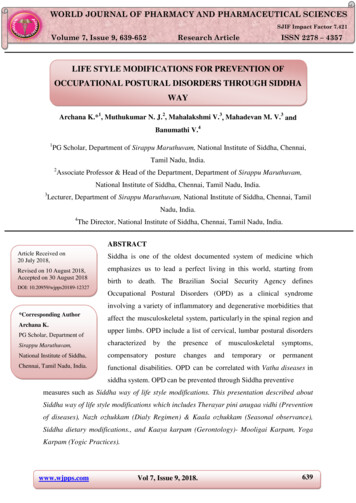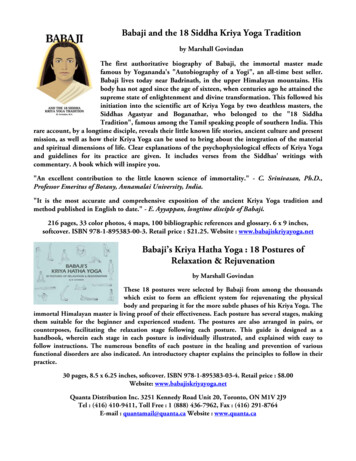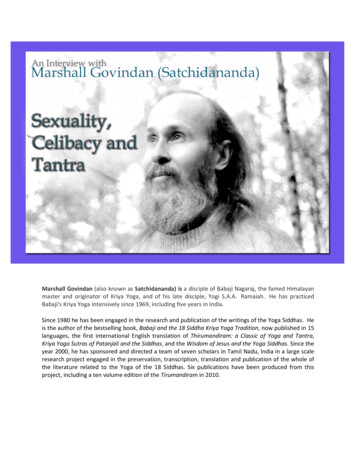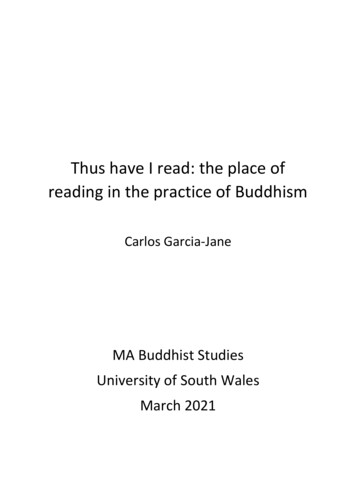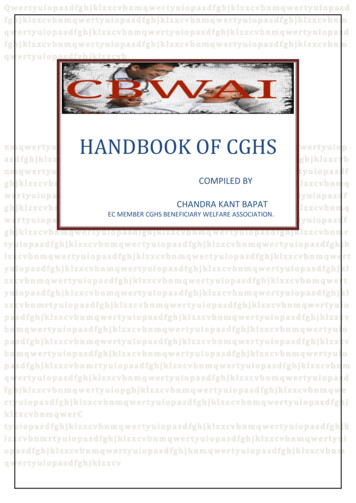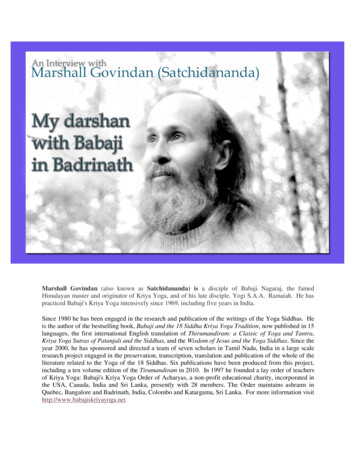
Transcription
Marshall Govindan (also known as Satchidananda) is a disciple of Babaji Nagaraj, the famedHimalayan master and originator of Kriya Yoga, and of his late disciple, Yogi S.A.A. Ramaiah. He haspracticed Babaji's Kriya Yoga intensively since 1969, including five years in India.Since 1980 he has been engaged in the research and publication of the writings of the Yoga Siddhas. Heis the author of the bestselling book, Babaji and the 18 Siddha Kriya Yoga Tradition, now published in 15languages, the first international English translation of Thirumandiram: a Classic of Yoga and Tantra,Kriya Yoga Sutras of Patanjali and the Siddhas, and the Wisdom of Jesus and the Yoga Siddhas. Since theyear 2000, he has sponsored and directed a team of seven scholars in Tamil Nadu, India in a large scaleresearch project engaged in the preservation, transcription, translation and publication of the whole of theliterature related to the Yoga of the 18 Siddhas. Six publications have been produced from this project,including a ten volume edition of the Tirumandiram in 2010. In 1997 he founded a lay order of teachersof Kriya Yoga: Babaji's Kriya Yoga Order of Acharyas, a non-profit educational charity, incorporated inthe USA, Canada, India and Sri Lanka, presently with 28 members. The Order maintains ashrams inQuebec, Bangalore and Badrinath, India, Colombo and Katargama, Sri Lanka. For more information visithttp://www.babajiskriyayoga.net
Interview with Marshall GovindanBy Anjula Duggal, http;//levitatingmonkey.comContents1. What is Kriya Yoga?. 32. As a graduate of Georgetown University School of Foreign Service and George Washington University inWashington D.C., how did you initially come to be interested in Kriya Yoga? . 33. What lead to your initiation in the early 1970s by Yogi Ramaiah? . 44. Talk to us about how your book, Babaji and the 18 Siddha Kriya Yoga Tradition, came about. . 55. Can you tell us about your two darshans with Baba Ji. (ie, When was it, what was context of the meeting, howdid it leave you feeling, what were action steps post the meeting as it relates to Kriya Yoga)?. 6
1. What is Kriya Yoga?MGS: Babaji's Kriya Yoga is a scientific art of God, Truth union and Self-Realization. It wasrevived by a great master of India, Babaji Nagaraj, as a synthesis of ancient teachings of the 18Siddha tradition. It includes a progressive series of 144 techniques or 'kriyas' grouped into fivephases or branches, originally taught and practiced over a period of twelve years, one techniqueper month. Paramahamsa Yogananda taught that practice of Kriya Kundalini Pranayama canaccelerate the natural progression of Divine Consciousness in human beings.2. As a graduate of Georgetown University School of Foreign Service and GeorgeWashington University in Washington D.C., how did you initially come to be interested inKriya Yoga?MGS: Throughout my adolescence growing up in West Los Angeles, I nurtured an interest inspirituality. But I was also inspired by John F. Kennedy’s words: “ask not what your country cando for you, but what you can do for your country.” After beginning my studies at Georgetown in1966, my interest in spirituality matured under the guidance of the Jesuit priest, Thomas O. King,a true mystic, who happened also to be the counselor at the end of the hall in my dormitory. Butit was the Autobiography of a Yogi that lead me to Kriya Yoga specifically It answered many ofmy existential questions and inspired me to apply to the Self Realization Fellowship, to commitmyself for life to their monastic order, with Father King’s encouragement. The SRF asked me towait for one year.“Sri Yukteswar,Babaji, Lahiri Mahasaya, Yogananadaon our publication”3
3. What lead to your initiation in the early 1970s by Yogi Ramaiah?MGS: Six months after entering the probationary period with the SRF, half way through mysenior year, I saw a two-line ad for “Kriya Yoga” classes in the local “Free Press,” newspaper. Istarted attending these in a one-room apartment off Dupont Circle. Two months later, inFebruary 1970, I attended the lecture and class given there by Yogi S.A. A. Ramaiah. He had amagnificent aura and his lecture and class so intrigued me that I began attending them everymonth, when he would come down from New York City on the Greyhound Bus. In the spring Ipassed the written and oral examinations to enter the United States Foreign Service, which untilthat time had been my career objective. But after receiving the first and second initiations intoBabaji’s Kriya Yoga from Yogi Ramaiah in his apartment ashram at 112 East 7th Street, in NewYork City, I began to feel conflicted about choosing career as a diplomat. I wanted to advance inthis Yoga, I wanted self-realization. I suppose it was dharma or destiny pushing in on my wellintended plans. The effects of the anti-war movement and the counter-cultural revolution inwhich I was an active participant beginning in Paris in 1968, had also given me serious doubtsabout making a commitment to supporting American foreign policy in particular, and Americanmaterialistic culture in general. I finally made a decision after raising the issue with YogiRamaiah. I remember asking him “What should I do?” Join the Foreign Service, or join hismission of Babaji’s Kriya Yoga? To his credit, he gave no encouragement to either alternative.He said I could become a diplomat and come and visit him whenever I liked. My decision not tojoin the Foreign Service was based upon my appreciation that this was a once in a lifetimeopportunity. Here was an authentic Master of Yoga and a genuine disciple of Babaji. If I wasgoing to advance in the field of Yoga, I would need to dedicate myself to it whole-heartedly.Yogi S.A. A. Ramaiah (1923-2006)4
And perhaps I could best make a difference in the world not by representing the U.S.government, but by serving one person at a time through Yoga.There was some subsequent irony to this decision. When I decided to join his mission, and beforemoving into a center he was setting up back in California, he wrote a letter in support of myapplication for exemption from military service to my draft board in Gardenia, California. Theboard gave me the exemption. I was probably the only person exempted from military service as a“seminary student” in a yoga ashram! Three years later, after a year in his ashram in Tamil Nadu,India, when Yogi Ramaiah sent me back to Washington, D.C. to serve our Kriya Yoga center there,after taking the U. S. Civil Service exam, I was offered two positions as an economist: one in theDepartment of Labor, and the other with the Chief of Naval Operations in the Pentagon. Afterasking him to advise me on which position to accept, he said that it would be best to take theposition in the Pentagon! So, I spent the next four years there, getting over the “duality” of myambivalence towards military service, until he asked me to move to Montreal, where he needed meto take over the center he had established there in 1970. So, my career of “foreign service” waselevated from government service to Babaji’s Kriya Yoga.4. Talk to us about how your book, Babaji and the 18 Siddha Kriya Yoga Tradition, cameabout.Babaji and the 18 SiddhaKriya Yoga Tradition5
MGS: In 1983, after 12 years of practicing the 144 kriyas for more than eight hours a day on theaverage, and helping Yogi Ramaiah to establish 23 teaching and sadhana centers around theworld, he gave to me a list of rigorous conditions to fulfill, to prepare me for the heavyresponsibility of initiating others into the advanced practices of Babaji’s Kriya Yoga. Afterfulfilling these conditions, Yogi Ramaiah asked me to wait. On December 25, 1988, Babaji toldme to leave Yogi Ramaiah’s organization and to begin to teach his Kriya Yoga. In 1990, I beganwriting this book as a means of sharing the knowledge which I had acquired pertaining to Babajiand his tradition, during the past two decades. Because I had lived and breathed its contents forso long and so intimately, it was also my offering to my Guru, Babaji, in the form of all potentialreaders. I had a very demanding editor, Dr. Desh Sikka, Ph.D, an early student in Montreal, whoobliged me to rewrite it five times: starting with the organization of the entire book, then that ofeach chapter, then that of each section, and finally every paragraph and sentence, tightening eachone up, removing all extraneous words. That is why every page is so packed with information.5. Can you tell us about your two darshans with Baba Ji. (ie, When was it, what wascontext of the meeting, how did it leave you feeling, what were action steps post the meetingas it relates to Kriya Yoga)?MGS: These occurred in early October, 1999, at Sapt Kund, also known as Saptopanth Tal, 20miles above Badrinath, on the other side of Mount Neelakantan. For many years, I have meditatedon going to Babaji's ashram there. It is known as Gauri Shankar Peetam. It has been described byV.T. Neelakantan, in his book Babaji's Masterkey to All Ills, and by Yogi Ramaiah in an earlyedition of his Kriya Yoga Magazine. Each of them were called there by Babaji, Neelakantan, on theastral plane, Yogi Ramaiah on the physical plane, in 1952 and 1954 respectively.This entire area around Badrinath is steeped in legends. Arjuna is reported to have gone to SaptKund to bathe and cleanse himself after the battle of Kurushetra. Vyasa is reported to have writtenthe Mahabharata in a particular cave at Mana, a village 3 km beyond the town of Badrinath. I havewritten about Badrinath itself in my book Babaji and the 18 Siddha Kriya Yoga Tradition.Yogi Ramaiah had taught me how to communicate with Babaji. I started visiting Badrinath in1986, with Yogi Ramaiah, after the Mahakumba mela in Haridwar.During my visit toBadrinath in 1998, Babaji told me to apply for permission to go into the restricted area aboveBadrinath the following year. No foreigners had ever been granted permission to enter this areabecause of its proximity to the border of Tibet and China. When our Chidambaram ashrammanager Neelakantan managed to get permission for us to travel hike up there, with the help of alocal businessman, Rohit, we found a local guide and hired three Nepalese porters. The six of ushiked up to this glacial lake, the source of the Alakananda River, in two days, reaching there onOctober 2. With the air containing only fifty percent the oxygen at sea level, the trek over theslippery ice and rock strewn glacier itself was extremely arduous.6
Santopanth Tal, October 1999Rohit and Govindan climbing toSantopanth TalAfter exploring the steep slopes around the sides of the lake for caves or places to erect a "lean -to"for shelter, as we had not brought tents, we decided upon a low stone wall, built up on three sides,about three feet high, which had been erected probably long ago by shepherds or pilgrims. I drapeda large plastic tarpaulin over it, and fastened it sides down with stones. I could enter it by the fourth,open side. Neelakantan moved into a nearby cave, eight feet long, with a low entrance, and justwide enough for him to lay down in. The porters moved into the kutir and unpacked.It was a glorious sunlit day, with sky bluer than anywhere else I'd ever seen. It seemed to be"popping" with pranic energy. In the afternoon, after lunch, I began to explore the area, praying thatI might find Babaji's ashram. From reading V.T. Neelakantan's account of his visit to Sapt Kund, Ihad anticipated that Babaji's actual ashram would be hidden. As there were no trails, only bouldersand rocks strewn and piled on top of one another on the steep slopes, exploring was not easy. Ifinally found a perch high above the lake, on a flat slab. From here, I could see almost the entirelake, as well as all of the surrounding mountains. Over the next few days I spent most of my timehere practicing many of the 144 Kriyas which Babaji had taught to Yogi Ramaiah here 45 yearsearlier.Later in the afternoon, I climbed down near the lakeside where I found a large cave underneath twolarge boulders. The entrance to the cave, was so low that I had to crawl into it, but once inside I7
could easily stand up in its center. It looked as though it may have served up to a dozen persons atone time. It had apparently been used for a group because in several places, stone seats were evidentnear the inner wall. I sat down in the far corner on a large flat stone and closed my eyes. Babaji'spowerful presence became evident and I was filled with rapture and light, a great expansion ofbeing, and a very deep peace. I was home.Later, upon leaving the cave, I discovered a fire pit, twenty yards down the slope, constructed fromstone, in a square in the traditional manner of a mantra yagna peetam. In it were the charcoalremains of a yagna fire. Four feet away from it on four sides were flat stones on which one couldeasily sit facing the fire. I was thrilled to find it, just as Yogi Ramaiah had depicted it in his paintingof Mataji washing the feet of Babaji. In fact, this painting which served as the basis of the paintingmade by my sister, Gail Tarrant, and reproduced on the rear cover my book Babaji and the 18Siddha Kriya Yoga Tradition was a remarkably accurate representation of the actual Satopanth lakescene. In particular, the three peaks in the background, which include Mount Neelakantan, and thesteep hills which border the lake on all sides, except the narrow area where Babaji and Mataji aresitting, were found to be the same as in these paintings.Over the next few days I continued to sit most of day in rapture on my perch high above the lake."What ineffable joy!" During my first meditation there, I clearly heard Babaji's voice say "Abide inme", and these words made such an impact on me that over the next days my consciousness "turnedinside out", so to speak. "That", "The Presence", came to the foreground and everything elsewithdrew to the background. The physical world as witnessed through the senses appeared asimages upon a movie screen. Perhaps the rarified atmosphere there, and the purification process ofwhat I'd been through during the past few days, not to mention 30 years of intense sadhana, nodoubt helped "set the stage". The show, however, was not about phenomena. It was the fusion of"consciousness" which had up to then been locked inside, with That Reality pervading everywhere.Such ineffable peace and tranquility. The absence of thought forms which are generally so commonwhere ever one finds human habitation (and physical and mental pollution) was remarkable. Thepure snow covered mountains towering above on all sides, stood like sentinels, guarding this sacredspace. They pointed skywards, towards blue infinity. The intense sunlight enlightened andpermeated everything. What rapture! Here, natural events, like the avalanches of snow and rockwhich occurred several times a day, took on new meanings. I marvelled at how the glacier uponwhich I sat and which surrounded me, had been built up over hundreds of thousands of years by thecumulative effect of such avalanches; and how their slow movement and melting had fed theGanges and the dry, dusty plains of India for thousands of generations. How interconnected we allare across space and time."Effulgent self consciousness", I'd exclaim at times, afterwards, when the mind made attempts todescribe the state. I drank deeply from the ocean of bliss pouring out of that deep glacier at SaptKund, one of the four major river origins of the Ganges.On October 5, 1999, between 3:30 and 5 p.m., I had the first of two visions of Babaji. I was seatedon my favorite perch, 100 yards above Saptopanth lake, when Babaji's radiant form appeared beforeme. He looked just like the photograph taken by V.T. Neelakantan nearly 50 years ago. Withcopper colored hair, fair brown skin, dark brown eyes, he was barefooted and wore only a paleyellow dhoti from his waist to his ankles. He walked towards me and embraced me. I felt diffused8
with a powerful golden light. "I am very happy that you received and acted upon the messages thatI sent to you telepathically", he said. "Despite all of the difficulties, and your heavy schedule, youhave finally made it here. I had to remove many obstacles to your coming here. I tapped the officerin Joshimutt to give you a pass. I kept it from snowing here all winter so that you could make itacross the glacier". He went on: "It is good that you did not bring a group, because the conditionswould have been too difficult and their distraction would have prevented you from receiving theexperiences I wanted you to have here." He then smiled when he said the following: "You have myblessings and the Order of Acharyas which you have founded in my name will gradually spread myKriya Yoga throughout the world". Then he gave me several important personal messages to relateto others.On the night before October 7, it snowed again, but this time very heavily. In the morning, aboutsix inches of snow covered everything. There was a risk of being snowed in if it continued.Fortunately, it was sunny October 7, but the snow was not melting. I decided that it was time tobreak camp and to leave. We had been told that during the previous winter it had not snowed at allbetween Badri and Sapt Kund, and that only because of this highly unusual occurrence, were weable to make our way up to Sapt Kund. While part of me will always remain there and is there evennow, the grosser vehicle could not have survived and was duty bound to "continue to deliver themail" to so many persons. Babaji is in everyone, and now I see Him clearly so! And that is perhapsthe message he wanted me to convey the most: "Seek Babaji to become Babaji", first in your ownhearts, then in everyone and everything.9
literature related to the Yoga of the 18 Siddhas. Six publications have been produced from this project, including a ten volume edition of the Tirumandiram in 2010. In 1997 he founded a lay order of teachers . of Kriya Yoga: Babaji's Kriya Yoga Order of Acharyas, a non-profit educational charity, incorporated in the USA, Canada, India and Sri .
